Alienware 18 Gaming Notebook Review
by Dustin Sklavos on September 16, 2013 12:00 PM ESTI'll admit we're getting a pretty solid workout with the NVIDIA GeForce GTX 780M. There are reasons, though. First, the 780M's performance has been very inconsistent since it launched. While some notebooks just needed driver updates (like the Alienware 18), most needed a BIOS update and driver update after the fact. And there's no getting around the fact that the 780M seems to be just plain underperforming. Is part of that due to Haswell? Certainly; for gamers, Haswell as an upgrade over Ivy Bridge is disappointing to say the least. But I suspect there's BIOS and/or driver tweaking still yet to be done to bring the 780M in line with where it really ought to be.
The other reason is that AMD just plain didn't show up to this party. There's a Radeon HD 8970M on the market, but AMD's Enduro is still a bit of a mess, and the 8970M itself is just a rebrand of the 7970M, a chip which already has a hard time competing with the 680M. If I were a betting man I'd expect actual competition to the 780M to materialize sometime in October or November. Hopefully the 780M's issues will have been completely ironed out by then.
Of course, with all that said, the 780M still works pretty well, and NVIDIA's SLI technology is incredibly sound and sturdy. The Alienware 18 boasts dedicated cooling for each GPU and the CPU, and the Intel Core i7-4900MQ should give the two 780Ms plenty of breathing room.
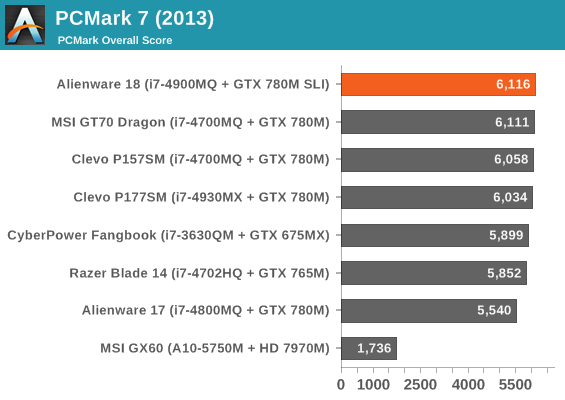
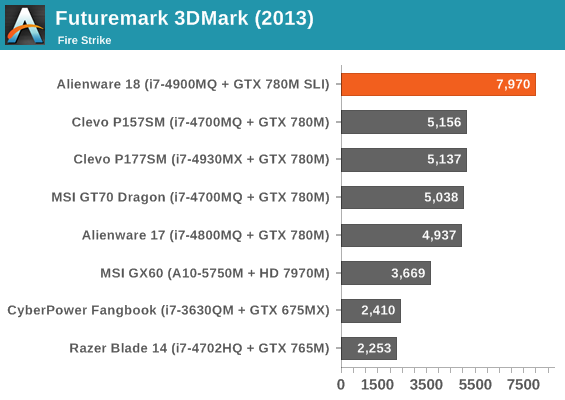
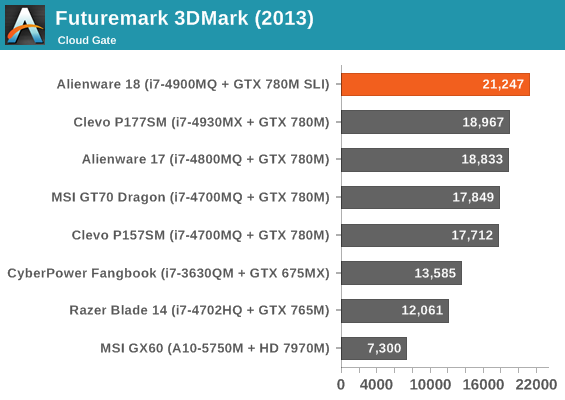
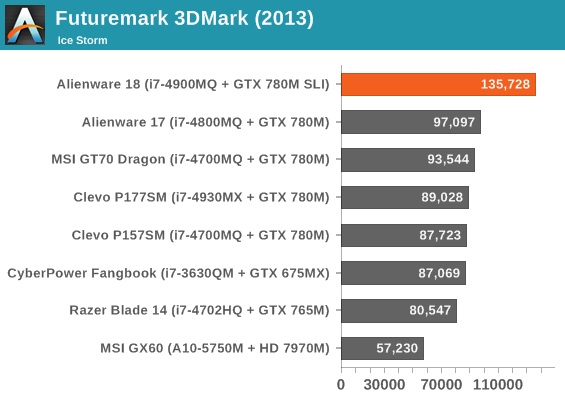
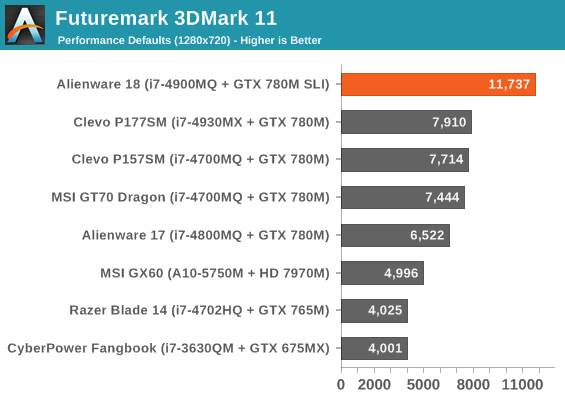
The Futuremarks are as kind to the Alienware 18 as they ought to be. What I want to point out is the PCMark 7 score. The MSI GT70 Dragon we tested is using three SSDs in RAID 0 while the Alienware 18 has to "make do" with a single 512GB (though you can certainly put multiple SSDs into it and stripe them), yet their PCMark 7 scores (a benchmark notoriously SSD friendly) are almost identical. While modern SSDs are hitting bandwidth limitations on SATA, I feel like you'd be hard pressed to really notice a difference with higher throughput in any practical applications.
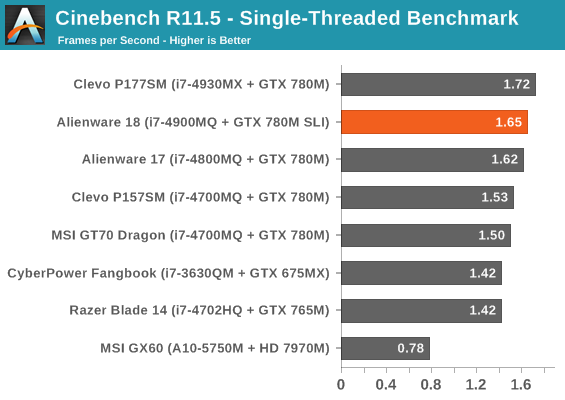
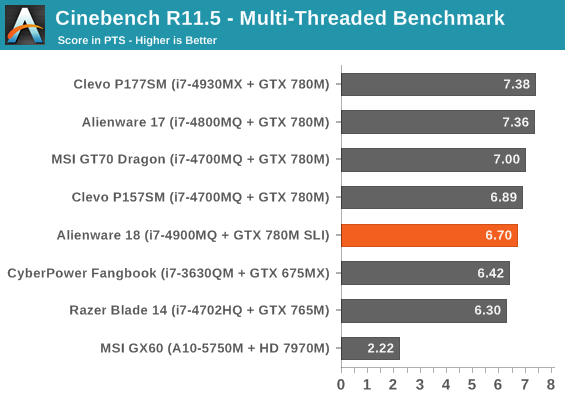
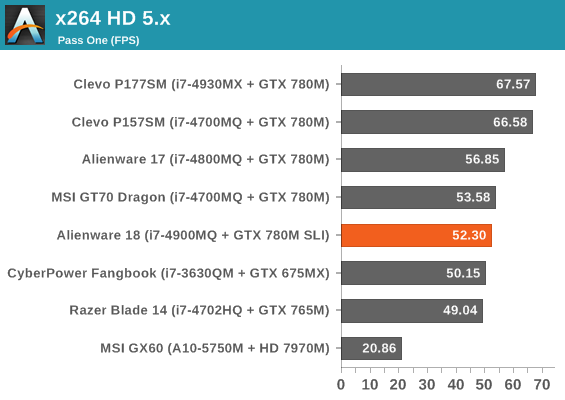
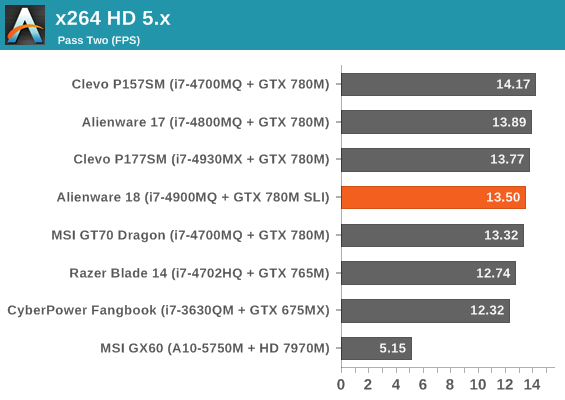
I'd be interested in figuring out why Haswell is underperforming in the Alienware notebooks, though. In our synthetics, the Alienware 17 and now the 18 just aren't stacking up where they ought to be, especially our x264 testing. Performance isn't alarmingly poor, but they're definitely having trouble keeping up with Clevo's Haswell implementations.










60 Comments
View All Comments
brucek2 - Monday, September 16, 2013 - link
Your original question asked about "all these weak resolution screens on notebooks nowadays", so it sounded a lot more like a question about the industry in general than this about particular machine.cjb110 - Tuesday, September 17, 2013 - link
Sorry but (a) is a terrible suggestion, given the lack of upgradability the machine should be built as a whole unit. For years gaming laptops have always suffered as they couldn't drive the panels they were paired with. Downscaling looks obviously crap, so kudos to Alienware by sticking with a panel their machine can actually game on.boeush - Friday, September 20, 2013 - link
"Downscaling looks obviously crap..."Why should it? In reality, it is upscaling. For instance, you render the game at 1920x1080, then scale up the result to 2560x1440 (if that's the actual display resolution, which IMO is what should be the case on an 18''+ high-end notebook!) As long as the aspect ratio is the same, the up-scaling will work well without any image distortion (and if done right, may even provide an additional antialiasing effect.)
brucek2 - Monday, September 16, 2013 - link
re: win7/8, I just now got a sales email from Dell. The big promo in the subject line? the usual Not -X% off, or +X% power, or FREE <gizmo> -- but"Want Win 7? Swap it out for free during Summer Clearance"
Promos of course are about telling customers what they want to hear, not necessarily about establishing truths. But still very telling that their research convinced them that this would be the most important selling point in a new system now.
kyuu - Wednesday, September 18, 2013 - link
Looks to me like a play at getting a few extra bucks by selling some old Win7 keys they have lying around to people who don't realize that Win7 offers nothing over Win8.Laststop311 - Monday, September 16, 2013 - link
The m18x is a truly superb machine if you like to goto your buddies and lan party it up. In that respect it is very portable. But like the article suggests it's much better building a mini itx system. I sold my m18x and used the proceeds to build a mini itx bitfenix prodigy setup.I got a i7-4770k OC'd to 4.8Ghz on all cores HT and turbo disabled. With the awesome Asus z87 mini itx boards. Cooling the CPU is a simple corsair h100i with 4 fans in push pull. 140mm exhaust in the rear and large 200mm intake fan in the front. 4 rad fans are the high static pressure noctua 120mm's and the rear is a 140mm noctua. Always use noctua fans they never let ya down. I've had the same 120mm noctuas for 4 years now and they are still as silent and deadly as the first day I got em. Xigmatek fluid circulative bearing 200mm fan for the intake is also dead silent.
PSU was a tough find. The problem is 160mm just barely fits and if you want a modular psu you need to go down to 140mm. The only modular psu with atleast 600 watts at that size was a silverstone. Luckily it does exist. I'm not a fan of dual GPU setups but I splurged and got a titan. If it wasn;t for getting a titan the sale of my m18x would of covered the whole build and a more modest gtx 770 but with next gen gaming around the corner and the new systems using up to 5GB V ram per game the Titan was the best future proof choice.
For storage we have the wonderful 512GB Samsung 840 Pro and a 4tb Seagate NAS model drive for its superior noise level. Paid only 250 dollars out of craigslist for the SSD it's also where i got my dell u3014 for 515. No optical drive installed the radiator on the top blocks it but who needs an optical drive really. Hvae an external usb 3.0 dvd burner in the house somewhere if I really need to use a disc.
As you can see selling the m18x r1 (I had it upgraded with gtx 680m in SLI and the triple pipe heatsink from the R2 extreme edition up from the single pipe the r1 came with and it had the i7-2960xm overclocked to 4.1ghz) led to me having a WAYYY better mini ITX set up. The single gpu titan with an overclock to 1067mhz and memory at 6.2ghz performs more fluid than the gtx 680m setup and even with the gpu's fan cranking up it's still much quieter than the laptop. CPU speed is a very large increase as well. So dustin is very much correct you can just build a mini itx system and put to rest the large heavy gaming notebooks.
The future of gaming notebooks is something like the razer blade 14 3rd generation. 6.5 hour HD video battery rundown time and impressive 1600x900 native resolution gaming in a package at about 4 pounds and 0.66" thick all the way around, no fatter bumps. It can have longevity like an ultrabook but also have gaming muscle. For 2000 with a 256GB mSATA SSD it's the way to go if you must have a gaming laptop. Other then that usage get a mini itx system + a cheaper haswell ultrabook with a good 8 hour battery life.
thesavvymage - Monday, September 16, 2013 - link
why would you buy the 4770k and then disable HT? Might as well have gotten the i5....ShieTar - Tuesday, September 17, 2013 - link
Yeah, I second that question. Especially for somebody who was looking for cost-efficient gaming, the 4670K would have made more sense.Then again, working hard to get an ITX gaming system, and then taking a 30", 24lbs monitor along with it doesn't make a whole lot of sense either.
5150Joker - Wednesday, September 18, 2013 - link
Hate to break it to you but if you compared benchmark results of your 680M SLI OC'd with an unlocked vbios, it would be nearly as fast as the bitfenix mini-itx system you built while being much better for portability. Furthermore, you could have upgraded that M18x with 780M SLI and when OC'd matches a Titan.5150Joker - Tuesday, September 17, 2013 - link
This review lost all credibility when the author tried comparing the M18 to an ITX desktop.